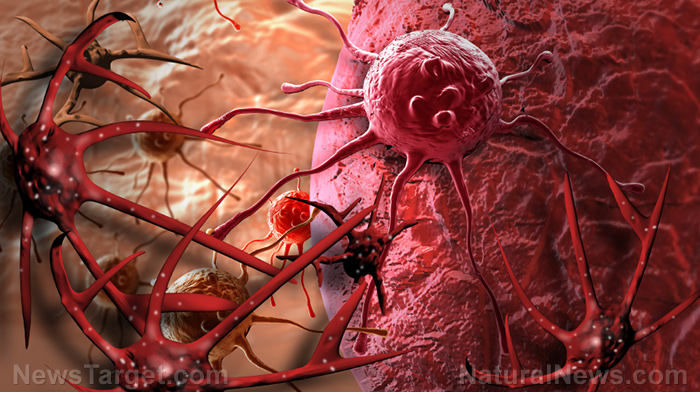
Malignant fibrous histiocytoma – causes, side effects and treatments at NaturalPedia.com
Thursday, May 31, 2018 by Janine Acero
http://www.naturalpedia.com/malignant-fibrous-histiocytoma-causes-side-effects-and-treatments-at-naturalpedia-com.html

A malignant fibrous histiocytoma (MFH) is a type of soft tissue sarcoma (malignant tumor). It originates in fibrous tissue that forms tendons and ligaments, and covers bones and other parts of the body. MFH most often occurs in the limbs, but it can develop in bones and anywhere in the body.
MFH mostly affects older adults, aged 50 to 70 years, and is rare in people under 20 years old. Moreover, it is more likely to occur in men than women.
Soft tissue is elastic and flexible, which makes tumor growth difficult to discover until its later stages. Most people realize they have MFH when they see a lump or swelling on their arm or thigh. The lump is normally painless, but it can cause discomfort if it compresses a nerve or muscle as the tumor continues to grow.
Staging for sarcomas is based on the size, grade (what the tumor looks like under the microscope and its predicted growth rate), and spread (metastasis) of the tumor. Below are the MFH stages:
- Stage I. The sarcoma is localized – the tumor has not spread, and is slow-growing. The smaller tumors are usually treated with surgery, but if the tumor is larger than two inches, radiation therapy or chemotherapy may be used.
- Stages II and III. The sarcoma is still localized but grows faster and larger. Surgical removal of the tumor is the first priority, but chemotherapy may given before surgery to shrink the tumor first. Chemotherapy and radiation may be used after surgery to make sure all the cancer cells are killed.
- Stage IV. In this stage, the cancer has spread to other parts of the body. If the spread is limited to nearby lymph nodes, then those nodes will be removed along with the tumor during surgery. If the cancer has spread to distant organs, a cure is probably not possible.
Patients with advanced tumors may have a five-year survival rate between 30 and 70 percent. People with soft tissue sarcoma such as MFH have a 20 to 30 percent chance of recurrence of another tumor in the same place (primary site).
MHF produces few symptoms, but as with most cancers, early detection is the key to surviving this cancer.

Known symptoms, risk factors for MFH
The causes of MFH are currently unknown, but some likely suspects include:
- Genetics: Genetic abnormalities could cause MFH.
- Radiation: Radiation therapy is a major risk factor for all soft tissue sarcomas, including MFH.
- Chemicals: Exposure to certain chemicals – such as vinyl chloride, arsenic, some herbicides, and wood preservatives that contain chlorophenols – is said to increase your risk of MFH.
MFH is characterized by a swelling over a bone or a bony part of the body; bone and joint pain; and a bone that breaks for no known reason.
Body systems harmed by MFH
MFH can metastasize (spread) to other parts of the body if left untreated.
Food items or nutrients that may prevent MFH
Calcium is a key nutrient in optimal bone health. Fortify your bones with the following foods rich in calcium and other bone-enhancing nutrients:
- Cheese
- Collard greens
- Eggs
- Fortified cereals
- Milk
- Orange juice
- Salmon
- Sardines
- Spinach
- Tuna
- Yogurt
Avoid the debilitating effects of cancer and improve cellular healing with these anti-cancer foods/supplements:
- Chlorella
- Fish oils
- Garlic
- Ginger
- Green tea
- Ground flaxseeds
- Selenium
- Turmeric
- Vitamin B complex
- Vitamin D (egg yolks, fatty fish, fortified milk)
- Vitamin E (almonds, avocado, broccoli, beans, mango, olive oil)
Treatments, management plans for MFH
MFH may be diagnosed using the following tools/methods:
- Imaging tests: X-rays, CT (computed tomography) scans, and MRI (magnetic resonance imaging) are used to detect and examine tumors. These tests are helpful in figuring out the size, shape, and spread of the tumor.
- Needle or surgical biopsy: During a biopsy, tissue from the tumor is removed and studied under a microscope to determine if cancer cells are present.
- Blood tests: Your doctor may want to check blood counts or test for hormones or enzymes indicative of cancer.
Treatment for sarcomas such as MFH, usually involves surgical removal of the tumor, followed by radiation or chemotherapy to kill off any remaining cancer cells. Surgeons try to spare as much of the affected limb as possible during surgery, but amputation may be necessary, especially if the cancer has spread to the bone.
Some patients opt for a more natural approach to treatment, which mainly involves supplements listed above, as well as massage (such as aqua pressure), calcium-rich diets, and herbal medicine to manage the symptoms, which include maitake, bupleurum, psoralea and astralagus.
Increase healing in your body by removing toxins using any or all of the following detoxification techniques:
- Exercise
- Infrared saunas
- Coffee enemas
- Castor oil packs
- Dry brushing
- Consume an anti-cancer diet
- Drink lemon or mineralizing water
Where to learn more
- Top healing foods that fight cancer: Do you eat them often enough?
- Guyabano fruit acknowledged as a miracle cure for cancer
- Soursop leaves: Cure Cancer, Diabetes, Rheumatism
- Black Cumin Seed Oil – The Most Powerful Oil for Your Health
- Fight Tumor Re-Seeding with Natural Remedies
Summary
A malignant fibrous histiocytoma (MFH) is a type of soft tissue sarcoma that originates in fibrous tissue that forms tendons and ligaments, and covers bones and other parts of the body. MFH most often occurs in the limbs, but it can develop in bones and anywhere in the body.
MFH is marked by a swelling over a bone or a bony part of the body; bone and joint pain; and a bone that breaks for no known reason.
Sources include:
Tagged Under: Tags: Malignant fibrous histiocytoma





